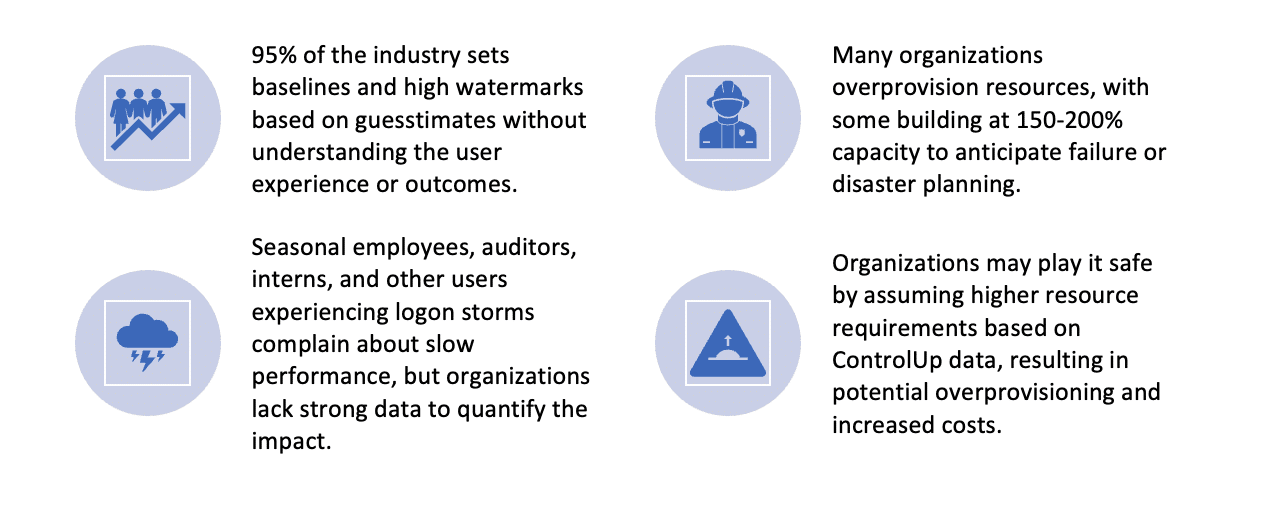The Risks of Over-Reliance on Monitoring Agent Data
May 4, 2023
We see many customers architect for the capacity of their virtual desktops and applications using vendor or cloud provider guidance. However, combining this information with CPU, RAM, and storage metrics observed during REAL user sessions, unfortunately, leads to inaccurate assumptions and inefficient resource allocation.
If you are one of the many still relying on cost calculators and guessing on critical decisions—we have some news for you; you are missing out on one of the most powerful and accurate points of comparison, end-user experience. Measuring and tracking end-user experience gives IT unparalleled visibility into the true performance of their environments, but how can this be managed without relying on true end-users?
The answer is to deploy virtual users into production environments to simulate realistic workloads.
Tracking from initial log-on to interaction with various business applications, IT can generate repeatable outcomes ideal for assessing performance, validating scalability, and planning capacity.
Hinging your environments’ performance, cost, and capacity on vendor guidance and real-user data pulled from a monitoring agent is a dangerous bet. With the constant change from OS upgrades, security agents, and the unknown around the corner, agent data doesn’t offer the performance or cost visibility needed for a successful configuration.
This is especially true if you are considering DaaS or a cloud provider to run your virtual desktops and applications. The approach used in an on-premises configuration is unreliable for building an efficient cloud-based environment because the underlying infrastructure and technology stack differ.
Cloud providers offer differing virtualization technologies, storage options, and network configurations compared to your on-premises setup. Following your on-prem configuration will lead to inefficiencies, suboptimal performance, or even security vulnerabilities in your cloud-based environment.
Measuring EUX and Capacity Planning with Precision
Making informed design decisions and avoiding inefficiencies or wasteful spending requires an understanding of how migration to new infrastructure will impact end-user experience.
Login Enterprise’s EUX Score measures desktop performance from the user’s perspective. This score factors in response time, availability, and reliability to help optimize resource allocation and prioritize user experience. In addition, IT admins and teams can use the tool to evaluate and compare different vendors to determine the ideal cost without compromising end-users.
Here is a real scenario experienced by one of our customers:
“To better aid us in achieving this goal, the Virtual Cloud Engineering team performed capacity planning. Using Login Enterprise with Amazon EC2 instance types to determine the best fit for our Citrix workloads. After analyzing our results for over 17 AWS EC2 instance types, we determined that we could implement the M5 Double Extra Large (M5 2XL) instance type with an increase in user density of 75% over the M4 Double Extra Large (M4 2XL), who ran our current workload. Based on our environment, this increased density and slightly lower hourly run costs equate to a theoretical savings of over 40% for one month in AWS. Login Enterprise enabled our team to mimic our Citrix desktop workload and better identify the AWS EC2 instance type that best suited our performance and cost requirements”, says an Engineer in IT Client Systems Management.
Gathering data from actual users can be ambiguous as you need more visibility into their workload during the modeling period. For example, users might be idle, active but not working hard, executing new workflows, or have multiple web browsers open, consuming more resources than expected. Due to this ambiguity, our customers often add 15-25% to account for potential resource usage.
Here are some statistics and problems associated with this approach:

- Inconsistent User Behavior: Real users have different usage patterns, with variations in application usage, logon/logoff times, and idle times. This can result in inconsistent and unpredictable resource utilization, making it difficult to establish reliable baselines for allocation.
- Difficulty Identifying Root Causes: When performance issues arise, relying solely on real user metrics can make it challenging to identify the root causes. It may be difficult to determine whether performance issues are due to resource constraints, application issues, or other factors, leading to guesswork in troubleshooting and resolution.
- Inability to Reproduce Scenarios: Real user sessions are influenced by various factors, such as network conditions, client device performance, and user behavior. These influences may not be reproducible during validation or troubleshooting scenarios, leading to inaccurate assumptions about resource requirements and performance expectations.
- Limited Scalability Analysis: Real user sessions may not accurately reflect the impact of increased user volume or sudden spikes in activity, such as logon storms or seasonal employees. This can lead to over- or under-provisioning of resources, resulting in increased costs or degraded performance during peak usage.
When it comes to performance management and resource allocation in production environments, utilizing virtual users offers significant benefits over traditional methods. Virtual users simulate a realistic workload, providing standardized and reproducible results for performance analysis, scalability validation, and capacity planning.
This approach enables organizations to make informed decisions based on reliable data to optimize resource allocation and proactively identify and resolve performance issues. Login Enterprise ensures that any changes are thoroughly validated before being rolled out, minimizing the risk of unexpected downtime or problems affecting end-users.
With valuable insights into system capabilities and limitations, IT leaders can ensure that their virtualized desktop environments operate at peak performance and better anticipate future needs.
Eliminate Guesswork with Concrete Data
Request a live demo today to discover how to reduce performance risk and optimize costs with Login Enterprise.
Agent Impact AnalysisPre-Production Visibility


